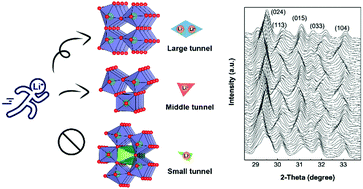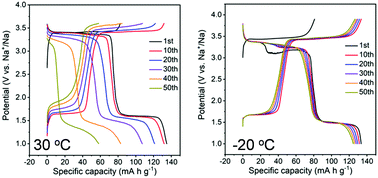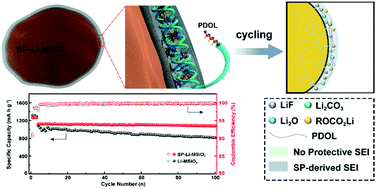Themed collection Electrochemical Energy

On the disparity in reporting Li-rich layered oxide cathode materials
Standard protocols of chemical compositions, synthesis pathways, calcination conditions, electrode preparation, battery fabrication, and battery testing are recommended in researching lithium-rich layered cathode materials for Li-ion batteries.

Chem. Commun., 2023,59, 2888-2902
https://doi.org/10.1039/D2CC04614H
A critical review of the nano-structured electrodes of solid oxide cells
Solid oxide cell (SOC) is one of the most important candidates for efficient storage and conversion of renewable energies from solar and wind power and the performance and stability of SOC is critically dependent on the synthesis methods and characteristics of nano-scaled electrodes.

Chem. Commun., 2022,58, 10619-10626
https://doi.org/10.1039/D2CC03877C
The development of catalysts for electrochemical nitrogen reduction toward ammonia: theoretical and experimental advances
This review summarizes recent theoretical and experimental progress relating to electrocatalysts for eNRR, discusses challenges in the field of eNRR, and provides perspectives for the design of efficient eNRR electrocatalysts.

Chem. Commun., 2022,58, 10290-10302
https://doi.org/10.1039/D2CC03410G
Chasing protons in lithium-ion batteries
The parasitic reaction between the cathode and the electrolyte is facilitated by the coordination bonding between the carboxyl groups and the interfacial transition metal ions. A stable cathode electrolyte interface can be achieved by (1) blocking coordination bond, (2) retarding electron transfer, and (3) hindering the diffusion of protons towards the cathode material.

Chem. Commun., 2022,58, 10127-10135
https://doi.org/10.1039/D2CC03970B
Strategies and characterization methods for achieving high performance PEO-based solid-state lithium-ion batteries
Polyethylene oxide (PEO) based polymer electrolytes have been widely used in solid-state lithium batteries (SSBs) owing to the high solubility of lithium salt, favourable ionic conductivity, flexibility for improved interfacial contact and scalable processing.

Chem. Commun., 2022,58, 8182-8193
https://doi.org/10.1039/D2CC02306G
Insights into interfacial chemistry of Ni-rich cathodes and sulphide-based electrolytes in all-solid-state lithium batteries
Critical issues including interface instability and mechanical failure between Ni-rich cathode active materials and sulphide-based solid-state electrolytes are thoroughly summarized. And corresponding strategies are elaborated comprehensively.

Chem. Commun., 2022,58, 5924-5947
https://doi.org/10.1039/D2CC01220K
In situ visualization of synergistic effects between electrolyte additives and catalytic electrodes in Li–O2 batteries
In situ atomic force microscopy was employed to track the dynamic O2/electrolyte/electrode interfacial reactions at nanoscale, revealing the synergistic effect between electrolyte additive K+ and Pt nanoparticles electrode in Li–O2 batteries.

Chem. Commun., 2022,58, 13381-13384
https://doi.org/10.1039/D2CC04808F
Spatially confined magnesiothermic reduction induced uniform mesoporous hollow silicon carbide nanospheres for high-performance supercapacitors
Well-dispersed mesoporous hollow SiC nanospheres (∼95 nm in diameter) were fabricated via in situ magnesiothermic reduction. The unique construction enables a high-rate capacitance (τ0 of only 0.34 s) and long cycle stability for supercapacitors.

Chem. Commun., 2022,58, 12455-12458
https://doi.org/10.1039/D2CC04723C
Vacancy-enhanced oxygen redox and structural stability of spinel Li2Mn3O7−x
Soft-chemistry prepared spinel [Li4/7Mn2/7□1/7]8a[Li4/7Mn10/7]16d[O4−x′]32e (Li2Mn3O7−x) with both Li–O–□ and Li–O–Li configurations exhibits oxygen redox and low-strain features during cycling.

Chem. Commun., 2022,58, 11685-11688
https://doi.org/10.1039/D2CC03259G
Effect of the metal–support interaction in platinum anchoring on heteroatom-doped graphene for enhanced oxygen reduction reaction
The supporting material with an optimal structure not only changes the growth behavior but also tunes the electronic structure of the catalyst.

Chem. Commun., 2022,58, 11519-11522
https://doi.org/10.1039/D2CC03505G
Stabilizing the interface of PEO solid electrolyte to lithium metal anode via a g-C3N4 mediator
Graphitic carbon nitride is introduced to the PEO-based solid polymer electrolyte as a mediator to stabilize the interface to a lithium metal anode.

Chem. Commun., 2022,58, 10821-10824
https://doi.org/10.1039/D2CC03310K
From inert to active: a cocktail-like mediation of an Ag/Ni mixture for electrocatalytic ammonia oxidation reaction
A facile hand-mixing of inert powders of Ag and Ni induces a highly selective electrocatalytic ammonia oxidation reaction, providing new insights into mechanistic understanding.

Chem. Commun., 2022,58, 10631-10634
https://doi.org/10.1039/D2CC03764E
A new Li-rich layered cathode with low lattice strain for lithium-ion batteries
A new C2/m layered Li2Ni0.2Mn0.4Ru0.4O3 cathode demonstrates high energy density along with extremely small volume strain during the electrochemical process.

Chem. Commun., 2022,58, 10488-10491
https://doi.org/10.1039/D2CC04044A
Sodium storage mechanism of a GeP5/C composite as a high capacity anode material for sodium-ion batteries
The sodium storage mechanism of a GeP5/C composite electrode was revealed. The GeP5 phase is revealed after recharge along with elemental Ge and P, implying a reversible phase transition of GeP5 during cycling.

Chem. Commun., 2022,58, 10345-10348
https://doi.org/10.1039/D2CC03728A
Multi-component surface engineering of Na3V2(PO4)2O2F for low-temperature (−40 °C) sodium-ion batteries
A functional Na3V2(PO4)2O2F cathode with a multi-component (Na3V(PO4)2, V2O3, and reduced graphene oxide) surface coating is developed, and exhibits high reversible capability, and long-term cycling stability even at a low temperature of −40 °C.

Chem. Commun., 2022,58, 10349-10352
https://doi.org/10.1039/D2CC03281C
Introducing competitive adsorption species in sulfonimide salt-based electrolytes for inhibiting aluminium corrosion
The inhibition of aluminium corrosion for 4 V-class cathodes within LiTFSI-based electrolytes by introducing competitive adsorption species.

Chem. Commun., 2022,58, 10341-10344
https://doi.org/10.1039/D2CC03434D
Choline chloride enhances the electrochemical stability of zinc plating/stripping
Choline chloride is employed as a high-performance bifunctional additive to enhance the stability of zinc plating/stripping.

Chem. Commun., 2022,58, 10088-10090
https://doi.org/10.1039/D2CC03276G
Li(110) lattice plane evolution induced by a 3D MXene skeleton for stable lithium metal anodes
Designed 3D MXene skeletons can effectively induce the evolution of advantageous Li(110) facets, and contribute to a dendrite-free anode interface and bulk Li formation.

Chem. Commun., 2022,58, 9373-9376
https://doi.org/10.1039/D2CC03288K
Subtly manipulating Zn2+-coordinated configurations with a complexing agent to boost the reversibility of the zinc anode
By manipulating the Zn2+ coordination environment, electrolytes with diverse Zn2+–En configurations effectively inhibit zinc dendrite growth and side reactions.

Chem. Commun., 2022,58, 9104-9107
https://doi.org/10.1039/D2CC02769K
Electrolyte design for inorganic-rich solid-electrolyte interfaces to enable low-temperature Li metal batteries
Rationally-designed electrolyte promotes robust SEIs with favorable interfacial conduction and accommodation, thus decreasing operation temperatures of Li-metal batteries to −40 °C.

Chem. Commun., 2022,58, 8994-8997
https://doi.org/10.1039/D2CC03096A
A Wadsley–Roth crystallographic shear phase SrNb6O16 anode for fast Li-ion storage
Wadsley–Roth phase SrNb6O16 with large-sized tunnels is explored as the first strontium niobium oxide anode material for fast Li+ storage.

Chem. Commun., 2022,58, 8626-8629
https://doi.org/10.1039/D2CC03208B
Vanadium dissolution at 30 °C and its suppression at a low temperature of −20 °C for a Na3V1.5Cr0.5(PO4)3 cathode
Na3V1.5Cr0.5(PO4)3 cycled at 30 °C shows fast capacity decay, due to the migration of V ions into the electrolyte and the loss of V3+/V4+ redox.

Chem. Commun., 2022,58, 8488-8491
https://doi.org/10.1039/D2CC02715A
Oxygen vacancies on Nb2O5 enhanced the performance of H2O2 electrosynthesis from O2 reduction
The presence of oxygen vacancies on the Nb2O5 electrocatalyst increases the adsorption of oxygen and then accelerates the 2e− ORR.

Chem. Commun., 2022,58, 8428-8431
https://doi.org/10.1039/D2CC02577A
A highly stable pre-lithiated SiOx anode coated with a “salt-in-polymer” layer
An artificial “salt-in-polymer” SEI was constructed on the surface of Li-MSiOx particles to maintain the structural integrity and inhibit the parasitic reaction at the electrode/electrolyte interface during cycling.

Chem. Commun., 2022,58, 7920-7923
https://doi.org/10.1039/D2CC02605H
A thin free-standing composite solid electrolyte film for solid-state lithium metal batteries
A thin free-standing CSE film of 15 μm is prepared with a wide electrochemical stability window and high ionic conductivity.

Chem. Commun., 2022,58, 7646-7649
https://doi.org/10.1039/D2CC02203F
Spin state engineering of spinel oxides by integration of Cr doping and a p–n junction for water oxidation
Enhanced electrocatalytic oxygen evolution activity on spinel Co3O4 has been realized by the integration of Cr doping and a p–n heterojunction.

Chem. Commun., 2022,58, 6642-6645
https://doi.org/10.1039/D2CC02175G
About this collection
Electrochemical energy systems that convert and store electrical energy through chemical reactions have played a vital role in providing power to modern industry. Driven by a rising demand from the emerging energy-dependent industries such as grid storage and electric vehicles, the pursuit of electrochemical power sources with higher energy density and efficiency, better economic sustainability and higher safety has become a major research focus. In particular, high-performing lithium/sodium/potassium ion batteries, lithium/sodium-sulfur batteries, solid-state lithium batteries, fuel cells and supercapacitors have received great attention in recent years.
This collection, guest-edited by Shaojun Guo (Peking University) and Haijun Yu (Beijing University of Technology), highlights research and review articles dealing with advanced materials and technologies for electrochemical energy conversion and storage.